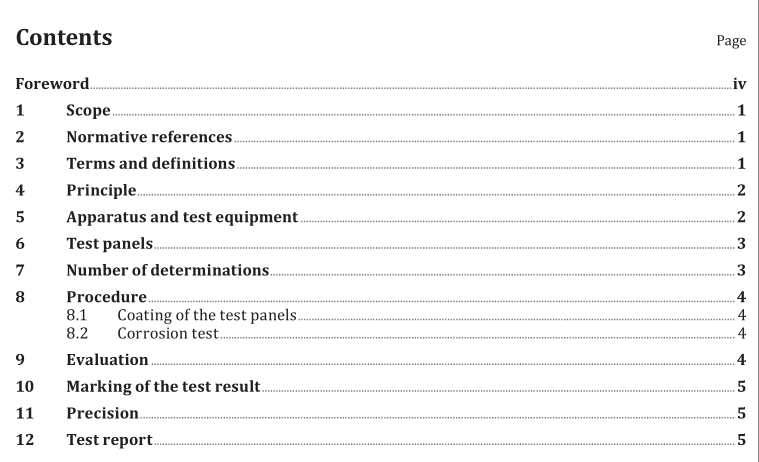ISO 22553-10 pdf download

ISO 22553-10 pdf download Paints and varnishes — Electro- deposition coatings — Part 10: Edge protection
1 Scope
This document specifies a test method for the evaluation of protection against corrosion of edges andstamping burrs by electro-deposition coatings.
lt applies to electro-deposition coatings for automotive industries and other general industrialapplications,e.g.chiller units,consumer products, radiators, aerospace, agriculture.
2Normative references
The following documents are referred to in the text in such a way that some or all of their contentconstitutes requirements of this document.For dated references,only the edition cited applies.Forundated references, the latest edition of the referenced document (including any amendments) applies.ISO 1514, Paints and varnishes — Standard panels for testing
ISO 2808, Paints and varnishes – Determination of film thicknessISO 4618, Paints and varnishes —Terms and definitions
ISO 4628-1,Paints and varnishes — Evaluation of degradation of coatings — Designation of quantityand size of defects, and of intensity of uniform changes in appearance —Part 1: General introduction anddesignation system
ISO 9227,Corrosion tests in artificial atmospheres — Salt spray tests
ISO 11997-1:2017, Paints and varnishes — Determination of resistance to cyclic corrosion conditions 一Part 1: Wet (salt fog)/dry/ humid
IS0 11997-31 ),Paints and varnishes —Determination of resistance to cyclic corrosion conditions —Part 3:Testing of coating systems on materials and components in automotive construction
ISo 13076, Paints and varnishes —Lighting and procedure for visual assessments of coatingsISO 22553-1,Paints and varnishes — Electro-deposition coatings — Part 1: Vocabulary
ISO 23321,Solvents for paints and varnishes – Demineralized water for industrial applications 一Specification and test methods
3 Terms and definitions
For the purposes of this document, the terms and definitions given in lSO 4618,ISO 22553-1 and thefollowing apply.
ISO and IEC maintain terminology databases for use in standardization at the following addresses:- ISO online browsing platform: available at https:.//www.iso.org/obp
5.4Oven, in which the test can be carried out safely and in which the specified or agreed testtemperature can be held to within ±2 C(for temperatures up to 150 C) or ±3,5 °℃(for temperaturesbetween 150 C and 200°c).
6 Test panels
Use electrically conductive test panels with pre-treatment as specified in IS0 1514 with dimensions ofabout 190 mm x 105 mm x 0,75 mm.
Five holes with a diameter of 20 mm and a stamping burr of about 90° are stamped into the test panel.The side with the stamping burr shall be marked.
NOTE1 The height and the roughness of the burrs on the backside of the holes could have an impact on thecorrosion.
The test panels are pre-treated in accordance with the product specification of the electro-depositioncoating material (e-coat).
NOTE2 Experience has shown that holes prepared by laser cutting lead to different test results comparedto stamped holes.An internal comparison with holes prepared by laser cutting has shown results with poorerreproducibility data.
An example for a test panel is shown in Figure 2.
7 Number of determinations
Carry out the determination in triplicate.
Procedure
8.1Coating of the test panels
Fill the tank with the electro-deposition coating material up to about 1 cm below the upper part of thetank and homogenize the coating material, e.g.using a stirring machine with paddle stirrer (minimumdiameter 50 mm) at 500 min-1, so that sufficient tank circulation is visually detectable.
Immerse the test panel in the laboratory deposition system and connect the anode and cathode to thecurrent source.Maintain stirring of the electro-deposition coating material with a stirring machine ora magnet stirrer.
Set the bath temperature to the temperature specifically required for the product to ±0,5 °C.NOTE 1 Usually the temperature is in the range from 25 °C to 35 c.
Select the deposition voltage and deposition time so that the expected dry film thickness of the electro-deposition coating on the test panel corresponds to the nominal dry film thickness.
Increase the voltage to the selected coating voltage (if necessary without series resistor).Maintain thatvoltage over the selected time.
After completion of the deposition process,remove the coated test panel from the tank.Rinse itthoroughly using demineralized water specified in ISO 23321,so that any excess of the electro-deposition coating material (cream coat) is removed.
Stove the electro-deposition coating in accordance with its specifications.
The stoving temperature shall be the object temperature, not the indicated oven temperature.NOTE 2 The stoving temperature is usually between 140°C and 180°C.
After the test panel has cooled down, measure the dry film thickness in accordance with one of themethods specified in ISO 2808 at three points of the test panel, and calculate the mean value.









